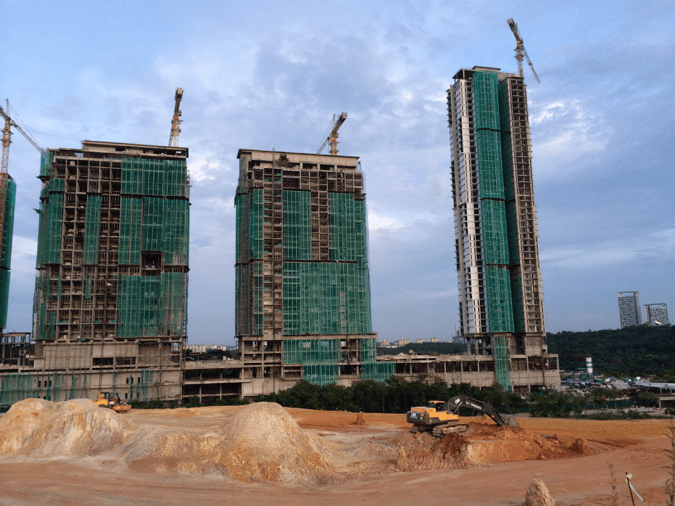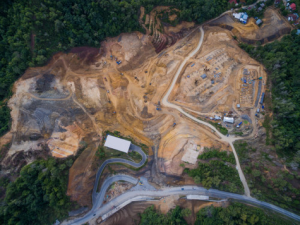The Adoption of Drone Technology in Construction Industry

Construction industry plays a pivotal role in developing country such as Malaysia. It is one of the earliest sectors identified under the national economy. It helps to realize the aspirations of meeting basic needs of the people and providing the infrastructures that are much needed by them. This article will look at factors affecting the adoption of new technology in the construction industry in Malaysia by using drone as an example.
Conservative Industry As Identified By Many
In Japan, the term “i-Construction” refers to development of standards to integrate information and communication technology (ICT) with the construction industry. The goal of i-Construction initiative is to drive innovation and revolutionize productivity in construction industry. Productivity is currently a challenge worldwide due to decrease in the number of workers and saturating market. Among the productivity-related issues in the construction industry in Malaysia are limited adoption of modern practices, mechanization and IBS, limited adoption of information technology such as BIM and lack of data and information-driven decision-making. Use of software during design, scheduling and planning, costing and tendering and project management phases are more widespread compared to actual application of the technologies on site. In actuality, the construction industry has been slow and reluctant to adopt new technology. Understanding which technology to use for different job functions can be overwhelming to such a conventional industry.
While there are smaller contractors, sub-contractors and consultants getting interested in new technology because they want to have a differentiator, many more are adopting a ‘wait-and-see’ approach. More over, Malaysian construction industry is used to top-down push when it comes to introducing changes. Technology will be used when a major international client that has embraced technology made it compulsory for their consultants and subcontractors to work using the same platform and tool. Unbeknownst to the international clients, the construction industry in Malaysia is still struggling to attain the advantages of data analytics, cloud storage services, Big Data, BIM, robotics, automation and mechanization, and drone despite the advancement in technology innovation. For many years, the construction industry failed to improve in their productivity. Thus, the adoption of these technologies can definitely make a change.
The Dawn of Drones in Construction Industry
PwC Global Report on Drone in 2015 akin the drone technology disruption as comparable and on a similar size of IT revolution that transformed the modern economy in the 1980s. Drones are cost effective data acquisition tool for aerial images. A lot of construction companies have been motivated by the benefits of adopting drone to enhance the effectiveness of process at worksites. However, some of them also found that their investment in this technology has outweighed the benefits and failed to meet their expectation. One of the most significant current discussions in drone-powered solutions is fragmented solution for data analysis. Currently, there aren’t any particular solutions that can satisfy the spectrum of needs for construction companies.
The governing body and the construction industry in Malaysia are consistent in their opinion that drone is useful in all construction phases (pre, during, and post). Their opinion is also coherent with drone service providers. These three groups found that drone are most useful in providing aerial photos and aerial videos particularly for these 3 specific purposes, 1) progress report, 2) monitoring, and 3) marketing and promotion. This could be attributed to the drone ability to maneuver easily and capture high resolution aerial photos and videos from every possible angles. The construction industry also recognised the potential usage of drone in mapping and land survey work in not too distant future since the new and improved technology is now available.
Giving Meaning to Visual Data
Extracting meaning and interpreting visual data from drone refers to actionable data. Actionable data brings value to business. The advancement in Internet of Things (IoT) has allowed drone solution and service providers to conduct data interpretation using data analytics tool for large volume of data, design analytics, and prediction analysis tools, and also build a complete 3D model of a building based on visuals from drone.
In Malaysia, these type of services are only sought after by clients with a complex project that covers a large area of land, or with multiple stakeholders. For infrastructure projects such as railways or highways, the interpretation of visuals helps them to manage the public perception more efficiently as compared to the previous method of using 2D drawings and plans. However, the most common usage of drone by construction companies is still confined to aerial visuals in the form of photos and videos to support their reporting document. To some, this is already a game-changer.
Data from drone has to be processed so it can give meaning and value to us. Recommendations and insights based on the data captured by drone must be provided in the most comprehensive way, as fast as possible. Users expect data to be readily available on every type of devices, accessible anytime and from anywhere. Therefore, smart collaboration that involves many components such as software, precision machine control, cloud-based system, real-time connection, location of construction site, and mobile technologies will contribute to the success of this technology adoption. Data accessibility will be a key driver in adoption of drone technologies in the construction industry.
Factors Affecting The Adoption of Drone Technology
There are several factors affecting drone uses that can be divided as push and pull factors. Push factors are 1) cost, 2) infrastructure readiness where ICT is not fully being utilized by the construction industry, 3) no urgency to use drone technology since it is not a standard set by the government or a company Standard Operating Procedure, 4) accuracy and data integrity is questionable, 5) there’s no protection against third parties liabilities, and 6) rules and regulations imposed by the governing body such as Department of Civil Aviation (DCA), JUPEM, Malaysian Communications and Multimedia Commission (MCMC), and Malaysia Unmanned Drone Activist Society (MUDAS).
The pull factors are benefits realization whereby 1) drone helps to avoid non-compliance, project delays and costly mistakes by companies, 2) saves time and reliable, 3) inspection service is replicable with big data and visual analytics system, and 4) it allows data sharing across borders with the cloud-based system. Another major pull factor is visionary leaders that exist whether they are industry leaders or in a higher management inside an organization. The embedded corporate culture such as Kaizen and encouragement of idea generation to improve processes using bottom-up approach also plays a role in affecting the drone uses.
Who Are Drone Early Adopters?
There are several Malaysian construction companies that have the traits of early technology adopters. Common traits are they are the leading construction and developer companies, a regular for local construction projects and have international clients, and always looking for a differentiation strategy. The company leaders are visionaries, they are cautious and will make the decision to invest in new technology once they’ve seen and convinced with the benefits that it would give in terms of change management and productivity of a company. These traits were also identified and described by drone service provider company for their major clients.
Break the Silos and Share the Benefits
There were some resentment withregards to adoption of new technology among construction companies. The use of visualization technologies especially drone in the construction industry in Malaysia is still at a nascent stage. But the solution is to understand what is the problem in the industry and identify areas that can be improved. The biggest issue identified is to improve situational awareness of a project throughout the chain for all the stakeholders from top decision makers to consultants, engineers, architects so that everybody is aware of what is happening. This will help them to make the right decision.
The benefits of drone in complementing current standard of construction practice is not widely spread among the industry yet. However, there might be projects in silos which didn’t come to light since there was no sharing of information by the companies. At the moment, there is no local reference to quantify drone benefits with monetary value. If the benefits can be quantified, it will help the industry to have a better understanding on it and will probably able to convert a non-user to a user. To pull together the fragmented ecosystem and break the silos, the establishment of a consortium would probably be a good way to start. The main driver of the consortium could be a neutral governing body with members consisting of construction and developer companies, associations, institutions of higher learning and drone solutions and service provider. The wide range of expertise under one roof will encourage information sharing, spark integration and collaboration in the effort to accelerate the adoption of new technology.

